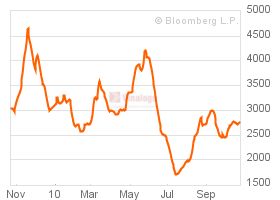Shipping indices
How do we know the current situation of shipping market? Well, shipping indices can effectively help us assess the market status.
Is market doing good or bad? Is it going up or down? Some reliable indicators can help us to answer our questions. A pretty simple rule is: increasing indices suggests better markets, and vice versa.
As a shipping carrier (like shiping lines or NVOCC), you are likely to keep abreast of changes in shipping market. To another extent, shippers, international traders and other shipping-related parties: forwarders, port operators also care for these market indicators, because the numbers may affects directly to their organizations’ expenses and revenue.
Baltic Dry Index

In maritime shipping world, people are usually quite familiar with Baltic Dry Index, which reflects the cost of chartering (hiring) vessels for transporting major raw materials. The index covers dry bulk and tanker, but not container market. If you want to learn more about BDI, click here.
Container Shipping Index
In container shipping segment, there’s no such a unified index to use thoroughly as BDI. In other words, there’re many indices reflecting container transport market at the same time. Usually, large consultant or broker companies compile their own indices. There’re 2 types using in container shipping industry: freight rate and charter rate indices. I list main indices below.
Charter rate indexes include:
- Clarkson
- Howe Robinson Index
- Harpex
- Maersk Broker Container Index
- Braemar BOXi Index
- Containership Time Charter Assessment Index
Freight rate indexes include:
- China Containerized Freight Index
- Shanghai Containerized Freight Index
- Drewry Container Freight Rate Index Published weekly on the JoC's By The Numbers page. This reports on the spot market (read: the rates that ocean carriers give to NVOCCs). If you follow it regularly, it gives you a pretty good idea of what the rate trends are. Combined with other information such as volume trends and economic forecasts, it can provide insights not only on trends, but on how people in the industry think and act.
Bi-monthly aggregate rate indices as US dollar-based weighted averages of multiple container freight rate benchmarks, namely:
- Drewry Global Freight Rate Index (excluding intra-Asia)
- Drewry Regional Freight Rate Index for Imports to the USA
- Drewry Regional Freight Rate Index for Exports from the USA
- Drewry Regional Freight Rate Index for Imports to Europe
- Drewry Regional Freight Rate Index for Exports from Europe
- Drewry Intra-Asia Freight Rate Index
Return to Home Page from Shipping Indices
New! Comments
Have your say about what you just read! Leave me a comment in the box below.